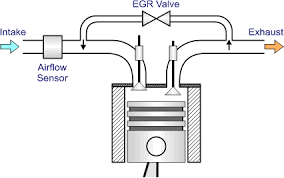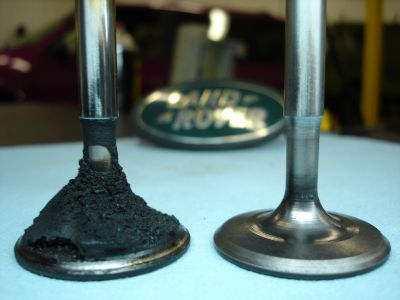Readers Reviews: What is Exhaust Gas Recirculation? (EGR)
Gather around kids! It’s story time.
Gather around kids! It’s story time.
Back when I was 16, I was stupid and naive. Being ridiculed for owning a Front Wheel Drive, I thought that having my Mazdaspeed3 output massive amounts of power would make me a “cool kid” in the car scene, and I would be able to hang out with the Supra and Mustang guys at my local car meets. Unfortunately, back then I didn’t have the money to spend on a big turbo, front mount intercoolers, forged internals, and Car Throttle stickers. Y’know, the keys of success to obtaining big power. My car felt like a small weakling compared to the cars that I wanted to hang around with. My car might as well have been Alex’s biceps.

With a pocket full of a desire to make big power, I immediately hit the internet and started doing my research to gain power on a budget. Upgraded Exhaust, ECU tuning and a free flowing Intake were all a part of the plan. To further increase my air flow, I thought it would be a great idea to port my manifold. Essentially I would have to take off my manifold, and grind the intake ports wider with a Dremel. During the process of taking it off, I came across a small copper pipe that was attached to the manifold. From what it looked like, the bolts attaching the pipe to the manifold were almost welded on. Being stupid and very frustrated, I decided it would be a good idea to just cut the pipe instead and use some rubber stoppers to plug the ends of the pipe.
With the manifold ported and back on the car, I took it out, excited to experience my performance gains. Within two minutes of driving, black smoke started to come out from under the hood, and my car broke down on the side of the road. $200 worth of parts and service brought me to the conclusion that the pipe that I cut was the Exhaust Gas Recirculation (EGR) pipe.
I guess it was important after all. Damn.
Having no idea what it was at the time, I did my research and discovered the hidden mysteries of this system. Now almost two years later, I’m a little fuzzy on the details. So here goes…
What is EGR?

Exhaust gas recirculation or commonly known as EGR, is a emissions control system being used on many vehicles today. Essentially, the system’s main purpose is to recycle a portion of exhaust gas back into the vehicle’s air intake, therefore reducing the overall emissions created by the vehicle.
Where this system can be very environmentally friendly and even cost effective, it does take quite a toll on the engine and its components.
Contaminated Intake AIR

Having hot, dirty, exhaust gases re-enter your intake is not the best idea. For one thing, having dirty air enter the intake defeats a purpose of the air filter. No longer is the air clean. Instead, the air is being mixed with doses of carbon. This causes the valves and other engine components to become very dirty and can be covered in carbon and soot. This can effect the “seal” of the intake and exhaust valves, causing the engine to lose compression, and can damage components.
I’m really not a big fan of the EGR system, it just seems wrong to me.
Think about it this way: Let’s say that your daily diet is like an EGR system. For most of your daily food intake, you eat really clean and healthy. Then, for some reason, for dinner, you eat your own excrement (poop) in order to be efficient and not wasteful.
THAT DOESN’T SOUND RIGHT, NOW DOES IT?
Sure, it’s efficient, but it’s nasty! And iIm about 10000% sure that eating your own poop does take a toll on your overall health. That’s some human centipede stuff! I don’t want to put my car through that!
Any solutions?
Easy, depending on what car you own, many aftermarket companies may make an EGR block off plate. This will stop the exhaust gases from entering your intake manifold.
Unfortunately, blocking off your EGR will most likely trigger a Check Engine Light. CEL. However, for keeping my engine clean and for better performance, that’s a sacrifice that I’m willing to make.

So, I hope you guys enjoyed my explanation of EGR! Have an awesome day, and be sure to never to cut random pipes on your car.
Cheers,
Bennett Cook (PerformanceandLuxury)
Automotive Student. Automotive Enthusiast.


Comments
Nice written, i think we need more posts like this. I really enjoyed reading it.
EGR block-off plate works for older cars. For example, my 1995 Audi A6. Audi even makes original block-off plates, lol. Newer cars require ECU remap, and most likely don’t even need blocking plates.
i had to disable this sh*t on 3 cars,including mine…
Newer cars don’t need blocking plate, but guy who programmed my EGR out of sistem told me that usually guys remap ECU and Add blocking plate, just to be sure.
Also in diesel cars EGR valves get stuck in one or another position and eat up even more power or trigger Check engine light.
The point of an EGR is to recycle inert gasses or unspent fuel back into the intake, it has the disadvantage of carbonizing everything it comes into contact with. the idea is that you use a smaller volume of fuel and air producing a more efficient vehicle. think of it as this a 2L engine will now behave like a smaller engine when saving fuel but it has the same flow as the 2L, as the power demand increases the EGR valve closes and allows for more performance.
Yes it is sh it just use a smaller engine with a bigger turbo, that usually solves the problem.
On my truck i just unplug it. Its directly on the front of the engine 😎
2.7CRD GRAND CHEROKEE MANIFOLD OFF TO REMOVE FLAP VALVES (plastic and prone to brake off and jam open inlet valves…), and de-EGR it!!
EGR valve,this goddamn EGR valve…change it 3 times on Astra 1.7
Changed 6 month later i bought my Mazda3, and changed 3 times in my old Fiesta 1.4. Damned EGR. However, incredibly simple and clear explanation, thanks!
Very nice explained. I like this kind of posts :)
Pagination